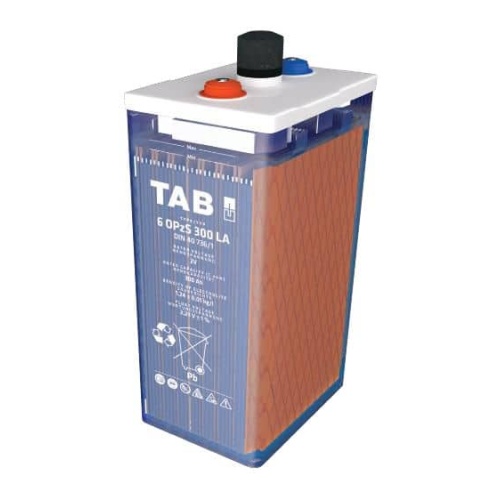- Free shipping to mainland Spain for orders over 300€.
OPzS batteries
The batteries OPzS are stationary lead-acid ventilated elements, manufactured with tubular positive plates y liquid electrolyte, a combination that provides high stability, long service life and reliable performance in deep cycles. They are a professional solution for systems that require continuous, stable, and long-lasting power.
They are especially recommended for off-grid solar installations, telecommunications, UPS systems, emergency lighting, substations, industrial control, and critical applications operating 24/7.
“TAB OPzS Battery Open PB Tubular Element 2V/250Ah – 5 OPzS 250” has been added to your basket. View basket
Electrical configuration and connection criteria
OPzS stationary batteries must be connected exclusively in series to form the system's nominal voltage bank (12, 24 or 48 V).
The parallel connection not admissible due to:
- Differences in internal resistance between vessels → imbalances in charging/discharging.
- Undesirable compensatory currents → overheating, differential sulphation.
- Accelerated reduction in the service life of the assembly.
Standard configurations:
- 12 V system: 6 glasses of 2 V
- 24 V system: 12 glasses of 2 V
- 48 V system: 24 glasses of 2 V
Any hybrid or parallel configuration should be ruled out due to premature degradation and risk of failure.
Service life and cycle curve
The service life depends directly on:
- Depth of discharge (DoD)
- Operating temperature
- Load voltage correction
- Regular maintenance
Typical example:
- DoD 60% → ~2,300 cycles
- DoD 30% → >4,000 cycles
- Temperature >30 °C → accelerated annual loss (~5%/year added)
Below 1.18–1.20 g/cm³ density after full charge, sulphation or electrolyte stratification may occur.

Recommended charging voltages
Typical values for 25 °C (correct ±30 mV/°C per vessel if the temperature differs):
12 V system (6 glasses)
- Absorption: 14.2 V
- Flotation: 13.4 V
- Equalisation: 14.7 V
24 V system (12 glasses)
- Absorption: 28.4 V
- Flotation: 26.8 V
- Equalisation: 29.4 V
48 V system (24 glasses)
- Absorption: 56.8 V
- Flotation: 53.6 V
- Equalisation: 58.8 V
If the temperature exceeds 30 °C:
→ Reduce tensions to prevent overload and accelerated water loss.
If the bank operates at <15 °C:
→ Increase them slightly to achieve nominal density.
Battery bank sizing
The OPzS capacity calculation must consider:
- Daily energy consumption (Wh/day)
- Required autonomy (days)
- Maximum allowable depth of discharge (DoD)
- System efficiency factor
- Nominal voltage of the bank
Required capacity (Ah):

The OPzS do not allow subsequent extensions, so the sizing must allow for a minimum margin of 20–30% about anticipated needs.
Compatibility with inverters/chargers
OPzS batteries are compatible with any charger or inverter that allows charge phase control:
- Absorption (Bulk/Boost)
- Floatation
- Equalisation
It must be verified that the charger allows:
- Charge currents within the recommended range: 0.1°C to 0.2°C (according to manufacturer).
- Manual adjustment of tensions and times.
A charger that does not allow periodic equalisation is unsuitable for OPzS.
Mandatory technical maintenance
Visual inspection
- Corrosion on terminals
- Leaks or crystallisation in the lid
- Deformation due to overheating
Electrolyte levels
Maintain between min./max. marks.
Use distilled water only.
Never fill before equalisation.
Electrolyte density
Check each glass:
Typical values at full load: 1.24–1.28 g/cm³
Differences >0.02 between vessels → possible internal deviation.
Equalisation
- Recommended frequency: Once a month
- Minimum duration: 1 hour
- Objective: to homogenise densities, reduce sulphation and mix electrolyte.
Environmental conditions
- Ideal temperature: 20–25 °C
- Avoid >30 °C (shortens life)
- Essential ventilation (ventilated batteries → H₂ emission during overcharging)
Frequent faults in OPzS installations
- Bank parallelism → irreversible imbalance
- Chronic undercharging → permanent sulphation
- No equalisation → acid stratification
- Installation in hot rooms → accelerated degradation
- Incorrect pressure settings → loss of capacity or excessive water consumption
- Inadequate cable sections → voltage drops and incomplete charging
- Loose terminals → hot spots and corrosion
Warranty and regulatory specifications
OPzS batteries for photovoltaic use usually incorporate 3-year warranty, and must comply with:
- IEC 60896-11 (ventilated stationary lead-acid batteries)
- DIN 40736 (OPzS design specification)
If the manufacturer does not declare regulatory compliance, it should not be considered for critical applications.
Components included in an OPzS pack
A complete set should include:
- OPzS glasses (6/12/24 depending on voltage)
- Intercell bridges and fixing screws suitable (usually tin-plated electrolytic copper)
- Vents with non-return valve
- Density meter (reading approx. 1.10–1.30 g/cm³)
- Basic tools: jug, funnel and protective elements
- Technical petroleum jelly for corrosion protection on terminals
This ensures proper assembly without introducing elements with unforeseen resistance or risk of electrolyte contamination.
If you need to validate the sizing, check the load configuration or ensure that the OPzS bank will meet the expected cycles, you can contact our technical support department at: info@fvcomponentes.com and our experts will help you select the right batteries for your project.

